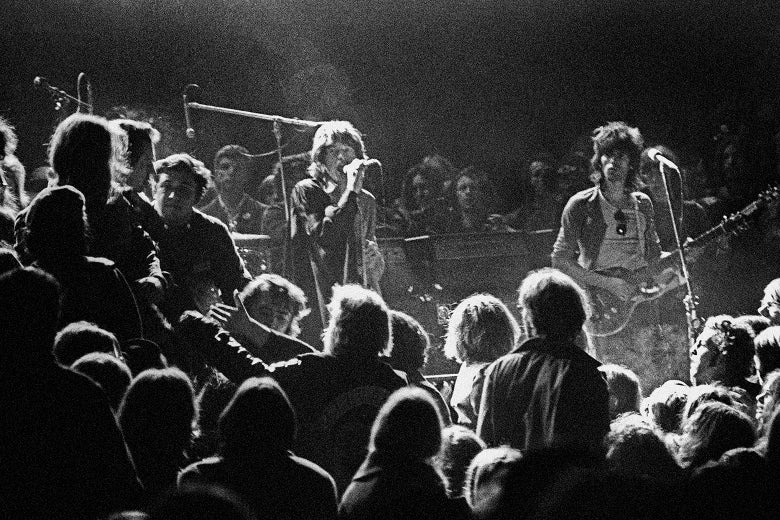
The Rolling Stones Disaster at Altamont: Let It Bleed
Rollingstone.com
Ididn’t know his name or anything, but he was standing along side of me. You know, we were both watching Mick Jagger, and a Hell’s Angel, the fat one. I don’t know his name or anything, he reached over — he didn’t like us being so close or something, you know, we were seeing Mick Jagger too well, or something. He was just being uptight. He reached over and grabbed the guy beside me by the ear and hair, and yanked on it, thinking it was funny, you know, kind of laughing. And so, this guy shook loose; he yanked away from him.
Altamont, a new music festival in Northern California, was the brainchild of the Rolling Stones, who hoped to cap off their U.S. tour in late 1969 with a concert that would be the West Coast equivalent of Woodstock, in both scale and spirit. Unlike Woodstock, however, which was the result of months of careful planning by a team of well-funded organizers, Altamont was a largely improvised affair that did not even have a definite venue arranged just days before the event.
The Chaos of Altamont and the Murder of Meredith Hunter
newyorker.com
n December, 1969, the photographer Bill Owens got a call from his friend Beth Bagby, who occasionally shot photos for the Associated Press. As Owens explains in his new photo book, “Bill Owens: Altamont 1969,” the A.P. wanted to hire him for a day “to cover a rock and roll concert in the Altamont hills.” The Altamont Speedway concert had been reported as the West Coast’s response to Woodstock. It was also part of a return to public view for the Rolling Stones, who had started touring again, after nearly two years off the road. Their efforts began in July, with a free show in London’s Hyde Park. The concert was a success, an entirely peaceful event financed and filmed by Granada Television. Security had been provided by a ragtag group of people wearing leather, who the Stones mistakenly believed were part of the Hells Angels. Emboldened, the Stones hired the man who organized the Hyde Park concert, Sam Cutler, to work on an American tour in the fall of 1969.
If the Woodstock festival in August 1969 represented peace and hippie idealism, then the Altamont Free Concert, held almost four months later, symbolically shattered that innocence. On December 6, 1969, about 300,000 gathered at the Altamont Speedway in Tracy, California to see the Rolling Stones perform a free concert that was seen as a ‘Woodstock West.’ It was also supposed to be a triumphant conclusion for the band that year, following their successful U.S. tour. But the event was marred by violent confrontations between the Hells Angels (who were hired to do security) and the crowd, in addition to lack of organization and bad drugs. By the end of the show, a total of four people died—among them 18-year-old Meredith Hunter, who was stabbed to death by a Hells Angels member, a moment captured in the Maysles Brothers and Charlotte Zwerin’s classic documentary film Gimme Shelter.
“Ooh, a storm is threatening/My very life today/If I don’t get some shelter/Ooh yeah, I’m gonna fade away.” So Mick Jagger sings for his “very life” at the beginning of “Gimme Shelter,” the apocalyptic anthem that kicks off the Rolling Stones’ classic “Let It Bleed” album, which was released 50 years ago on Dec. 5, 1969.
Those lyrics would prove to be prophetic when, on the following afternoon, the Stones arrived at the disastrous Altamont Speedway Free Festival in Livermore, California. “We’re walking off the helicopter, and a guy jumps up and punches Mick [Jagger] in the face,” recalled Ronnie Schneider, 76, who was the Rolling Stones’ 1969 US tour manager. “The guy was just out of his mind, punched Mick in the mouth, and I wanted to kill the guy. And Mick’s like, ‘Don’t hurt him, don’t hurt him.’ That’s when we knew we had a problem.”
The Rolling Stones ended their 1969 U.S. tour with a free concert at the old Altamont Speedway in northern California. It was supposed to be a celebration, but it turned into chaos.
A young fan was stabbed to death, allegedly by a member of the Hells Angels, right in front of the stage as the Stones performed. The killing was captured on film because a documentary crew was making the film called “Gimmie Shelter.”
Ethan Russell has a funny story about the late Jim Marshall, who helped create the archetype of the rock ‘n’ roll photographer. Marshall, who took epochal pictures of Bob Dylan rolling a tire and Johnny Cash flipping the bird, came across Russell on the sidewalk in San Francisco, at the height of the Haight-Ashbury hippie moment, snapping photos of the band Blue Cheer. Russell’s brother was one of the band’s managers, but that didn’t stop Marshall from issuing a threat.
“He said, ‘Get out of here, kid. This is my territory,’” Russell remembers with a laugh.
More than three decades after the killing brought a dark cloud over the 1960s free-love era, Alameda County sheriff’s investigators have shot down a theory that a second Hells Angel took part in the fatal stabbing of a Berkeley man that ended the Rolling Stones’ infamous concert at the Altamont Speedway.
Meredith Hunter, 18, described by friends as a flashy dresser with a big Afro, was swarmed by members of the Hells Angels motorcycle club on Dec. 6, 1969, as the Stones performed “Under My Thumb” after arriving late to the windswept pastures off Interstate 580.
Journalist Joel Selvin tells the definitive story of the Rolling Stones’ infamous Altamont concert in San Francisco, the disastrous historic event that marked the end of the idealistic 1960s.
Altamont Rock Festival: ’60s Abruptly End (Part I of II)
web.archive.org
As the 1960’s ended, Livermore was at the epicenter of a peculiar convergence of events one December weekend involving two “rock” icons of the decade: moon rocks and rock music. The Altamont Rock Festival, the largest public gathering in the history of eastern Alameda County, delighted an estimated 300,000 observers and taxed the area’s transportation, medical and law enforcement systems.
Investigators close decades old Altamont killing case
Meredith Hunter, 18, was killed during the free concert on Dec. 6, 1969, that was billed as a West Coast Woodstock. The concert, which drew an estimated 300,000 people, was later immortalized in the film documentary Gimme Shelter.
The Hells Angels Brought Death To Rock And Roll’s Worst Day
web.archive.org
Coined by Rolling Stone magazine as “rock and roll’s all-time worst day—a day when everything went perfectly wrong,” the 1969 festival at Altamont Speedway in Northern California was a concert unlike any other. While the free event provided a chance to jam out with The Rolling Stones and some of their famous counterparts, it also gave the fans one hell of a ride. Best known for its shocking violence, destruction, and chaos, Altamont was the angry, intoxicated ruffian who stole the innocence from the summer of love.
Behavioural risk at outdoor music festivals
researchgate.net = Aldo Raineri
Outdoor music festivals are increasingly common events on the summer entertainment
landscape for youth in many countries around the world. Evidence indicates that attendance is
associated with an increased risk of injury and death. Crowds are the principal hazard that
needs to be dealt with, and without effective management, can become a significant problem
with serious consequences. A considerable proportion of the safety risks associated with
outdoor music festivals can be attributed to anti-social, irrational and unsafe behaviour by
patrons. Encouragement of such behaviour has, to some extent, been a deliberate strategy on
the part of music promoters and press agents, resulting in patrons attending music events
becoming more aggressive and





